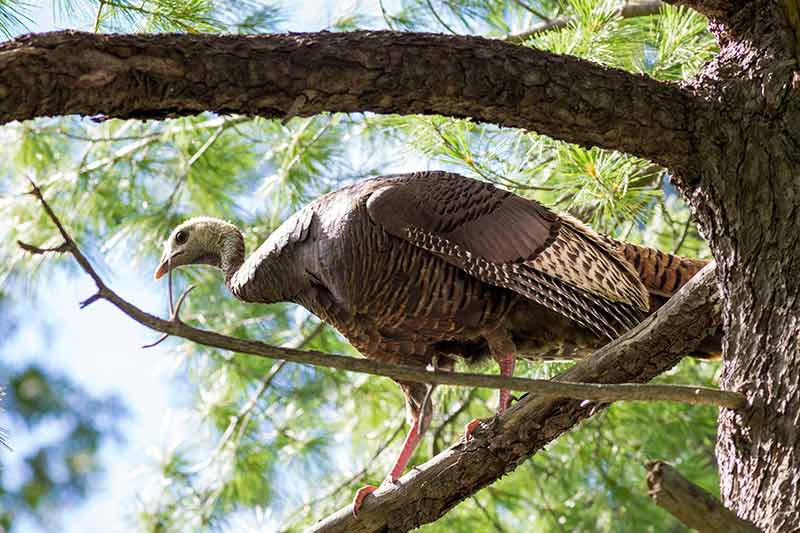By Dylan Stuntz, American Forests
This Thanksgiving, you might find turkey on your plate, but it generally isn’t of the wild variety. On the contrary, wild turkeys are found in forests across the country — 49 states, to be exact! Five subspecies are scattered throughout the continental U.S. and Hawaiʻi, indicating the turkey’s ability to live in a variety of forest ecosystems, from swamps to oak forests to deep desert.

Turkeys’ preferred habitat is mixed-conifer and hardwood forests, with various open spaces to find food, such as seeds, nuts, leaves and insects. Despite their large size, they are agile fliers and capable of roosting among high trees, either while foraging for food or avoiding predators.
Each subspecies prefers a unique habitat and possesses slightly different plumage, but they are all considered to be members of the same species of wild turkey (Meleagris gallopavo).
Eastern wild turkey
(Meleagris gallopavo silvestris)
Christened “forest turkey” by the Puritans in the 1800s, this turkey has the largest range of any subspecies. They can be found in much of the eastern U.S., spanning from the Canadian border to northern Florida and westward to the Mississippi River. They can be identified by the brown-tipped upper tail feather found on the male. Habitat for this subspecies is typically wet, swampy land, or early-growth forests with low-lying brush situated throughout.
Osceola wild turkey
(Meleagris gallopavo osceola)
This subspecies can only be found in southern Florida. The smallest subspecies of wild turkey, this bird has darker, green-tinged feathers and can be found among palmetto stands and swamps. Researchers estimate that 80,000 to 100,000 birds make up the population, but an accurate count is difficult to make because the bird’s swampy habitat isn’t very accessible to researchers.
Rio Grande wild turkey
(Meleagris gallopavo intermedia)
Found among the southern/central desert regions of the U.S. this bird was also introduced and has found a niche in northern California and Hawaiʻi. Out of the five subspecies, this one has the longest legs, which are best adapted to prairie living. The Rio Grande wild turkey can usually be found among scrub oak, mesquite and pine forests, as well as along streams and river bottoms.
Merriam’s wild turkey
(Meleagris gallopavo merriami)
These turkeys are native to the Rocky Mountains, clustering among forests of ponderosa pine. The back feathers of this subspecies are white-tipped. During the winter months, the turkeys will move down the mountain slopes to avoid snow, then return during the spring to feast on dropped seeds. The turkey was named after C. Hart Merriam, first chief of the Division of Economic Ornithology and Mammalogy of the U.S. Department of Agriculture, a division that would later become the National Wildlife Research Center and the U.S. Fish and Wildlife Service.
Gould’s wild turkey
(Meleagris gallopavo mexicana)
The largest of the subspecies, this turkey can only be found in Arizona, New Mexico and northern Mexico. Its feathers are copper-colored with a greenish tint. They frequent small underbrush, commonly found along dry creek beds. While this turkey inhabits a dryer climate than the other subspecies, it manages to subsist on a diet of insects, berries and seeds, scavenging wherever possible.
While each of these varieties of turkey may have slightly different habitat, one thing remains constant: To support a wild turkey population, the landscape needs to have vegetation. Turkeys co-exist with trees and forests all across the country, whether it be roosting in them, feasting on them or simply living among them.